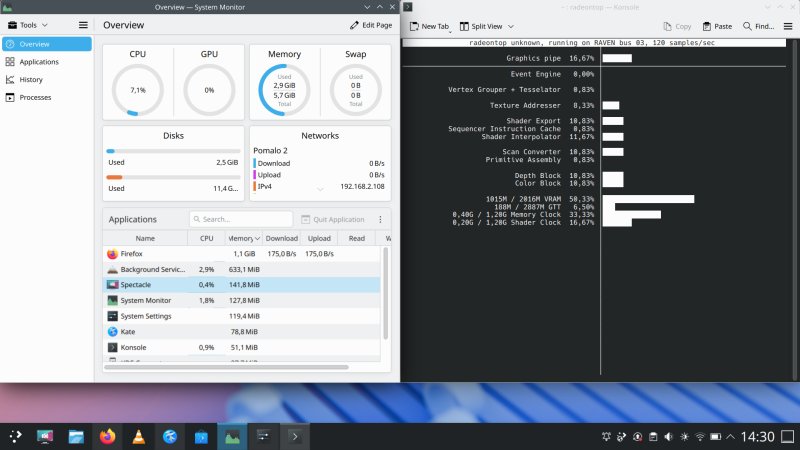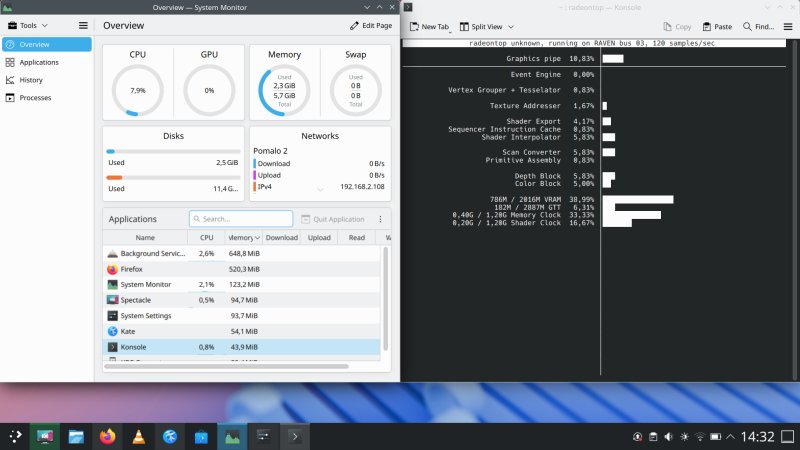Updated: July 1, 2025
Last Thursday, I published my review of the latest version of the fantastic Plasma desktop environment. It wasn't without flaws or problems, including notable issues with Wayland, the new display protocol thingie that's supposed to drive the desktop. On its own, this wouldn't be anything cardinal, except both Gnome and KDE teams are pushing heavily for having Wayland as the default display protocol, even though it still kind of beta, and it severely lacks in numerous areas, including basic usability, as I noted in my article. So we're heading toward a no-choice Linux future that's deeply, deeply troubling.
What makes the whole story even more interesting is the predictable range of response to my writing. You get the usual gamut of ad hominem nonsense, the "it works for me so it's a-ok" school of thought, and some reasonable discussion to and fro. Well, I thought, I did report a few problems, perhaps I can shed some more light on the issues. As I always said, I have nothing against Wayland, and if we can make it better, great! The only problem, the ONLY problem is the forced deprecation of X11 BEFORE Wayland is ready. Now, let me show you some more info on the AMD GPU 100% spikes under Wayland.

Spikes be spiking
If you search online for the likes of "amd gpu ubuntu 100% when idle", you will find a lot of results, some of which are relevant for Xorg/X11, some of which are relevant for Wayland. The following Reddit thread is probably the closest thing that could possibly explain what I've seen, and it might point to various issues or bugs in the kernel. However, in my case, the spikes only manifest on Wayland. Sure, if you do things and actually utilize the GPU, you will see a certain percentage going up both under X11 and Wayland. It's the idle behavior on Wayland that's troubling.
Furthermore, there seem to be all sorts of bugsy messages in the system and kernel log related to my card. However, again, it is not clear why the potential problems would only affect Wayland.
amdgpu: psp gfx command LOAD_TA(0x1) failed and response status is (0x7)
amdgpu: psp gfx command INVOKE_CMD(0x3) failed and response status is (0x4)
amdgpu: Secure display: Generic Failure.
amdgpu 0000:03:00.0: amdgpu: SECUREDISPLAY: query securedisplay TA failed. ret 0x0
Let's explore deeper, shall we?
Results with radeontop
AMD offers a free utility called radeontop - you can install it from the (Ubuntu) archives and run it like you would top. The only difference is, it shows GPU data rather than CPU/memory information.
sudo apt install radeontop
And here are the results, first Wayland + power efficiency display mode:

Wayland + color accuracy mode:

X11 session:

In all of the cases, I used the same set of programs, everything minimized except System Monitor on the left and a konsole windows on the right, with radeontop running inside it, polling the system at its default interval. And of course, there's Spectacle (with its timeout), but you cannot see that window.
I didn't try to "wait" for the spikes to show, I let the Spectacle do its thing - of course, these three images only show a snapshot of a behavior, not a trend. As you can imagine, when there's a spike, the numbers are even worse. Anyhow, the radeontop values, excluding zero values and caches (all percentages):
| Metric | Wayland +
power efficiency |
Wayland +
color accuracy |
X11 session |
| Graphics pipe | 8.33 | 16.67 | 10.83 |
| Texture Addresser | 3.33 | 8.33 | 1.67 |
| Shader Export | 5.83 | 10.83 | 4.17 |
| Shader Interpolator | 5.83 | 11.67 | 5.83 |
| Scan Converter | 6.67 | 10.83 | 5.83 |
| Primitive Assembly | 0.83 | 0.83 | 0.83 |
| Depth Block | 5.83 | 10.83 | 5.83 |
| Color Block | 6.67 | 10.83 | 5.00 |
| VRAM | 49.19 | 50.33 | 38.99 |
| GTT | 6.24 | 6.50 | 6.31 |
| Memory Clock | 33.33 | 33.33 | 33.33 |
| Shader Clock | 16.67 | 16.67 | 16.67 |
I am no GPU expert, but you can clearly see that the X11 session tolls fewer resources pretty much across the entire board. As the KDE team says on their Display configuration page, using the Color Accuracy profile will definitely use more resources, and it does, compared to the Power Efficiency mode.
Overall, though, you can see that X11 is the lighter, more efficient display protocol even for trivial stuff, and this aligns with years and years of my testing, on multiple systems, multiple graphics card. Remember, this is a pretty run-of-the-mill IdeaPad 3 from late 2019, early 2020, with Vega integrated graphics. There's nothing fancy here that should trip the system, or pose any major usability difficulty. If you look at the numbers above, in the majority of the cases, X11 simply uses fewer GPU cycles. C'est la vie.
Then, to be a bit more thorough, I re-collected the data using radeontop with a 1s interval, for 60 seconds, with just the System Monitor and a Konsole window open, and not even the mouse cursor moving, for all three scenarios.
radeontop -i 1 -l 60 -d whatever-file.csv
To wit, the average values:
| Metric | Wayland +
power efficiency |
Wayland +
color accuracy |
X11 session |
| Graphics pipe | 3.31 | 4.03 | 2.47 |
| Event Engine | 0.00 | 0.00 | 0.00 |
| Vertex Grouper + Tesselator | 0.33 | 0.3 | 0.11 |
| Texture Addresser | 0.90 | 2.03 | 0.78 |
| Shader Export | 2.24 | 3.03 | 1.42 |
| Sequencer Instruction Cache | 0.06 | 0.08 | 0.03 |
| Shader Interpolator | 2.58 | 3.31 | 1.61 |
| Scan Converter | 2.54 | 3.18 | 1.54 |
| Primitive Assembly | 0.32 | 0.30 | 0.11 |
| Depth Block | 2.51 | 3.18 | 1.53 |
| Color Block | 2.51 | 3.18 | 1.54 |
| VRAM | 26.39 | 28.44 | 22.36 |
| GTT | 3.92 | 3.98 | 3.85 |
| Memory Clock | 33.33 | 54.90 | 54.81 |
| Shader Clock | 16.67 | 16.67 | 16.67 |
Even for a completely idle desktop, over a 1-minute period, X11 uses fewer resources. Here, I did include a couple of fields I omitted in the first table, and even for these, X11 still beats Wayland, across the board. The only value where Wayland is "better" is the average memory clock, in the power efficiency mode, which doesn't really mean much, as the GPU decides what speed it wants to run, for various reasons.
And if you don't trust me, I can upload the raw csv files, so you can do your own analysis.
You also won't believe me, but the CPU also ticked lower in the X11 session than in the Wayland one. Imagine what happens when you turn compositing off in X11.
Now, this isn't a PhD dissertation in statistics, but still, food for thought, people.
A couple more Wayland-related bugs ...
As it happens, there were still several more Wayland-specific issues:
- Plasma does restore your session, Wayland included, but the windows are all restored in the center of the screen, not their last position before logout or reboot. In X11, (most of) the windows are correctly restored.
- Spectacle in Wayland couldn't capture the mouse cursor, even if selected.
This feels beta. Very beta. But forced deprecation FTW!
Conclusion
The Linux world faces an important moment. A Microsoft moment. But not in the market share sense, no. In the lock-the-user sense. For the first time ever, the Linux user may now be faced with a Linux-only conundrum of what to run and where to compromise usability wise. Sure, if you want to migrate from Windows over, you need to take your software requirements into account. There ain't no 1:1 translation. But Linux folks never before faced this dilemma. Specialized enterprise software? Yes. You might have to run RHEL or alike, perhaps. Desktop software? There were no limitations.
With Wayland, unfortunately, those limitations are now in place. If you want to use Wayland, you may have to do with a reduced set of programs or use cases. And that's fine, if, I repeat, IF you want to use Wayland. But if you don't, then you face an ugly, arbitrary imposition. All I'm saying is, dear Linux people, please don't behave like the Googles and Microsofts of this world. We have enough corporate crap as it is. We don't need TPM-like moments in the Linux world. Let X11 be, if and UNTIL Wayland truly reaches maturity. And then, we can all happily switch, everyone, together. Quality for quality, no compromises, no usability lost.
As my testing above shows, performance is yet another sore point in the Wayland story. The most basic, trivial things are still meh. My focus is on Plasma, because I love Plasma, I use Plasma, I care about Plasma. I don't care so much about other desktop environments, and a few - none at all. But the message is for the entire Linux distroscape and their flavors. The whole move-fast, break-things, always-beta approach is bad. It's self-defeating. Don't let it be the defining characteristic of the Penguinland. Take care.
Cheers.